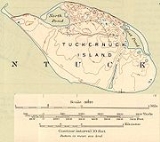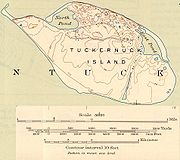
Tuckernuck Island
Encyclopedia

Massachusetts
The Commonwealth of Massachusetts is a state in the New England region of the northeastern United States of America. It is bordered by Rhode Island and Connecticut to the south, New York to the west, and Vermont and New Hampshire to the north; at its east lies the Atlantic Ocean. As of the 2010...
, west of Nantucket Island and east of Muskeget
Muskeget
Muskeget Island is a low sandy island to the west of Tuckernuck Island and Nantucket, in the town of Nantucket, Massachusetts.-Geography:Muskeget Island is part of the terminal moraine marking the maximum extent of the last glacial ice sheet to reach the northeastern coast. It has an area of . The...
. Its name allegedly means "a loaf of bread". The island has an area of about 900 acres (1.4 square miles).
Settlement
The island is privately owned by its summer residents. Approximately 35 houses have been built on Tuckernuck; the oldest home on the island was built in the mid-18th century. The island has no paved roads or public utilities. Electricity is generated by gas powered generators and solar panelPhotovoltaic module
A solar panel is a packaged, connected assembly of solar cells, also known as photovoltaic cells...
s. Water comes from several wells on the island and water heaters are generally gas powered, as are the stoves. The island has some cars, but most of the motorized transportation is provided by golf carts.
Geology
Tuckernuck was originally formed by the terminal moraineMoraine
A moraine is any glacially formed accumulation of unconsolidated glacial debris which can occur in currently glaciated and formerly glaciated regions, such as those areas acted upon by a past glacial maximum. This debris may have been plucked off a valley floor as a glacier advanced or it may have...
of the last glacial episode (Wisconsin glaciation
Wisconsin glaciation
The last glacial period was the most recent glacial period within the current ice age occurring during the last years of the Pleistocene, from approximately 110,000 to 10,000 years ago....
). It still retains remnants of the moraine as low hills, but the southern half of the island consists of outwash plains (sandur
Sandur
A sandur is a glacial outwash plain formed of sediments deposited by meltwater at the terminus of a glacier.- Formation :Sandar are found in glaciated areas, such as Svalbard, Kerguelen Islands, and Iceland...
) characterized by coastal heath
Heath (habitat)
A heath or heathland is a dwarf-shrub habitat found on mainly low quality acidic soils, characterised by open, low growing woody vegetation, often dominated by plants of the Ericaceae. There are some clear differences between heath and moorland...
land, a globally restricted and endangered plant community.
Flora
Coastal heathland occurs only in the Northeast United States, from Long Island, NY, to Cape Cod, MA. Dominant species include little bluestemLittle bluestem
Schizachyrium scoparium, commonly known as little bluestem or beard grass, is a North American prairie grass. Little bluestem is a perennial bunchgrass and is prominent in tallgrass prairie, along with big bluestem , indiangrass and switchgrass...
(Schizachyrium scoparium), bearberry
Bearberry
Bearberries are three species of dwarf shrubs in the genus Arctostaphylos. Unlike the other species of Arctostaphylos , they are adapted to Arctic and sub-Arctic climates, and have a circumpolar distribution in northern North America, Asia and Europe, one with a small highly disjunctive population...
(Arctostaphylos uva-ursi), and low ericaceous shrubs (Family: Ericaceae
Ericaceae
The Ericaceae, commonly known as the heath or heather family, is a group of mostly calcifuge flowering plants. The family is large, with roughly 4000 species spread across 126 genera, making it the 14th most speciose family of flowering plants...
). There are extensive areas of scrub oak
Scrub Oak
Scrub Oak is a general name for several species of small, shrubby oaks, including the following species:*California Scrub Oak *Leather Oak *Coastal Scrub Oak...
(Quercus ilicifolia) vegetation of up to 15 feet (5 m) in height, along with pitch pine
Pitch Pine
The Pitch Pine, Pinus rigida, is a small-to-medium sized pine, native to eastern North America. This species occasionally hybridizes with other pine species such as Loblolly Pine , Shortleaf Pine , and Pond Pine The Pitch Pine, Pinus rigida, is a small-to-medium sized (6-30 meters or 20-100 feet)...
(Pinus rigida), black huckleberry
Huckleberry
Huckleberry is a common name used in North America for several species of plants in two closely related genera in the family Ericaceae:* Vaccinium* GaylussaciaHuckleberry may also refer to:-Plants:...
(Gaylussacia baccata) and sweet pepperbush (Clethra alnifolia). Red maple
Red Maple
Acer rubrum , is one of the most common and widespread deciduous trees of eastern North America. It ranges from the Lake of the Woods on the border between Ontario and Minnesota, east to Newfoundland, south to near Miami, Florida, and southwest to east Texas...
(Acer rubrum) and black gum (Nyssa sylvatica) trees occur in kettlehole swamps. Other plants include American beachgrass (Ammophila breviligulata
Ammophila breviligulata
Ammophila breviligulata is a species of grass that is native to eastern North America, where it grows on sand dunes along the Atlantic Ocean and Great Lakes coasts...
), seaside goldenrod
Goldenrod
Solidago, commonly called goldenrods, is a genus of about 100 species of flowering plants in the family Asteraceae. Most are herbaceous perennial species found in the meadows and pastures, along roads, ditches and waste areas in North America. There are also a few species native to Mexico, South...
(Solidago sempervirens), poison ivy
Poison ivy
Toxicodendron radicans, better known as poison ivy , is a poisonous North American plant that is well known for its production of urushiol, a clear liquid compound found within the sap of the plant that causes an itching rash in most people who touch it...
(Toxicodendron radicans), bayberry (Myrica pensylvanica), beach plum
Beach plum
Prunus maritima is a species of plum native to the Atlantic coast of North America, from Maine south to Maryland. Although sometimes listed as extending to New Brunswick, the species is not known from collections there, and does not appear in the most authoritative works on the flora of that...
(Prunus maritima), saltspray rose (Rosa rugosa) and other shrubs on the stabilized dunes. There are a few small freshwater marshes and a salt marsh dominated by cordgrass
Cordgrass
Spartina, commonly known as cordgrass or cord-grass, is a genus of 14 species of grasses in the family Poaceae. They are native to the coasts of the Atlantic Ocean in western and southern Europe, northwest and southern Africa, the Americas and the southern Atlantic Ocean islands; one or two species...
(Spartina alterniflora).
Fauna
The largest concentration of Oldsquaws, or Long-tailed DuckLong-tailed Duck
The Long-tailed Duck or Oldsquaw is a medium-sized sea duck. It is the only living member of its genus, Clangula; this was formerly used for the goldeneyes, with the Long-tailed Duck being placed in Harelda...
(Clangula hyemalis) in the western Atlantic occurs nearby (counts of over 150,000 have been recorded), along with thousands of common eider
Eider
Eiders are large seaducks in the genus Somateria. Steller's Eider, despite its name, is in a different genus.The three extant species all breed in the cooler latitudes of the Northern hemisphere....
s (Somateria mollissima) and three species of scoter
Scoter
The scoters are stocky seaducks in the genus Melanitta. The drakes are mostly black and have swollen bills. Females are brown.They breed in the far north of Europe, Asia and North America, and winter further south in temperate zones of those continents. They form large flocks on suitable coastal...
(Melanitta spp.). In late summer a thousand or more roseate tern
Tern
Terns are seabirds in the family Sternidae, previously considered a subfamily of the gull family Laridae . They form a lineage with the gulls and skimmers which in turn is related to skuas and auks...
s (Sterna dougallii), a U.S. endangered species, feed near here in preparation for their southward migration. Extensive sandspits on Tuckernuck are favored haul-out points for large numbers of harbor and gray seals
Pinniped
Pinnipeds or fin-footed mammals are a widely distributed and diverse group of semiaquatic marine mammals comprising the families Odobenidae , Otariidae , and Phocidae .-Overview: Pinnipeds are typically sleek-bodied and barrel-shaped...
(Phoca vitulina and Halichoerus grypus, respectively). The island also supports many other state and federally rare species, including Nantucket shadbush (Amelanchier nantucketensis), a candidate species for listing under the Endangered Species Act; several pairs of short-eared owl
Short-eared Owl
The Short-eared Owl is a species of typical owl . In Scotland this species of owl is often referred to as a cataface, grass owl or short-horned hootlet. Owls belonging to genus Asio are known as the eared owls, as they have tufts of feathers resembling mammalian ears. These "ear" tufts may or may...
(Asio flammeus); piping plover
Piping Plover
The Piping Plover is a small sand-colored, sparrow-sized shorebird that nests and feeds along coastal sand and gravel beaches in North America. The adult has yellow-orange legs, a black band across the forehead from eye to eye, and a black ring around the neck...
(Charadrius melodus), a U.S. threatened species; least tern (Sterna antillarum); northern harrier (Circus cyaneus) and common tern
Common Tern
The Common Tern is a seabird of the tern family Sternidae. This bird has a circumpolar distribution, breeding in temperate and sub-Arctic regions of Europe, Asia and east and central North America. It is strongly migratory, wintering in coastal tropical and subtropical regions. It is sometimes...
(Sterna hirundo).
Public access
Tuckernuck Island is privately owned and is therefore off limits to uninvited guests.The south end of the island has a grass airstrip, which is seldom used.

